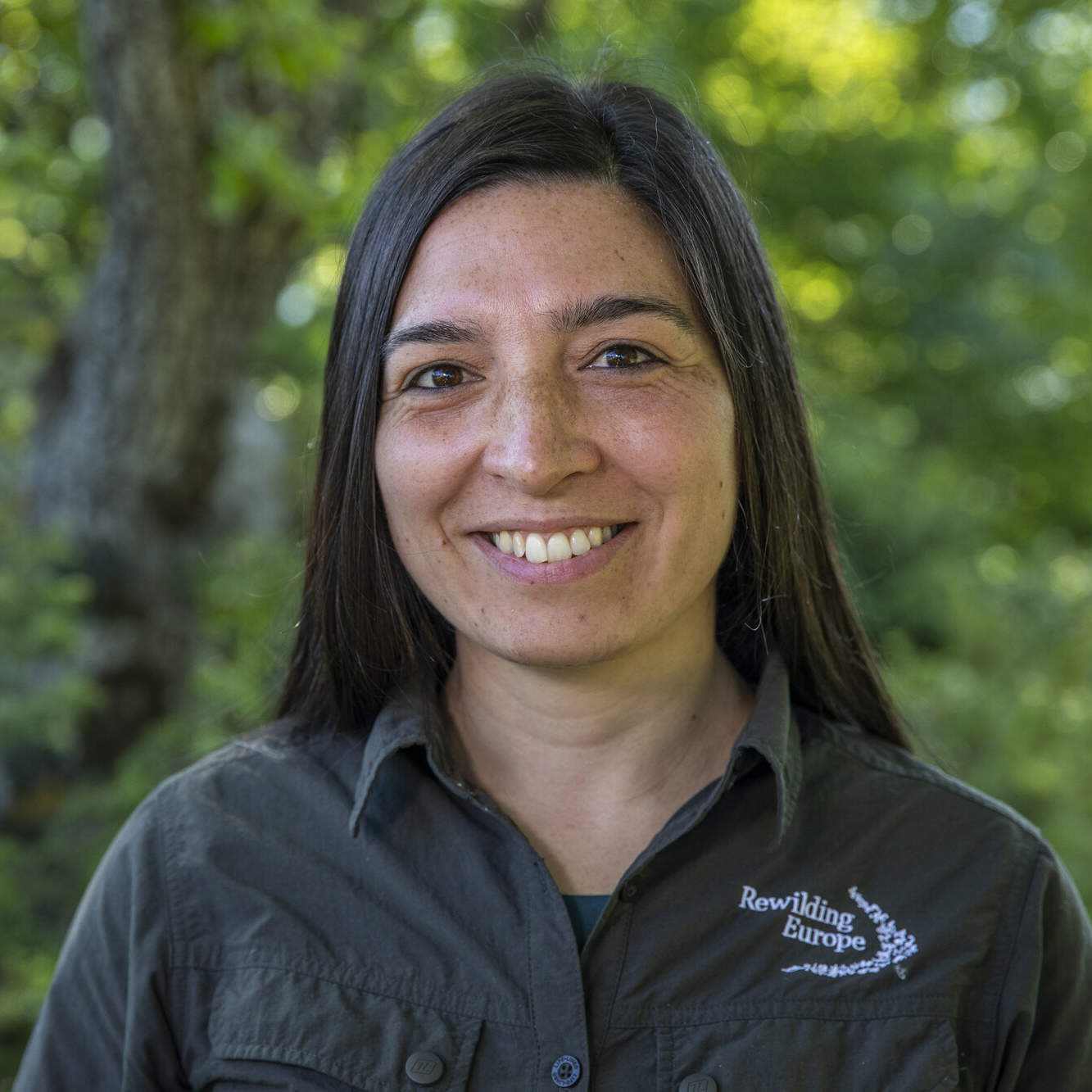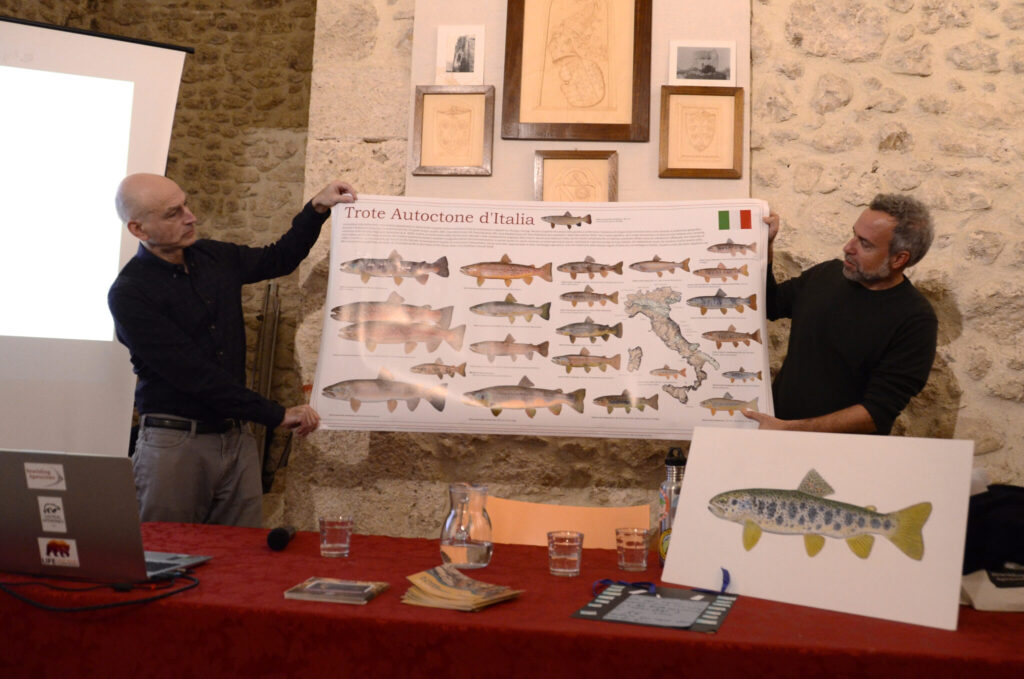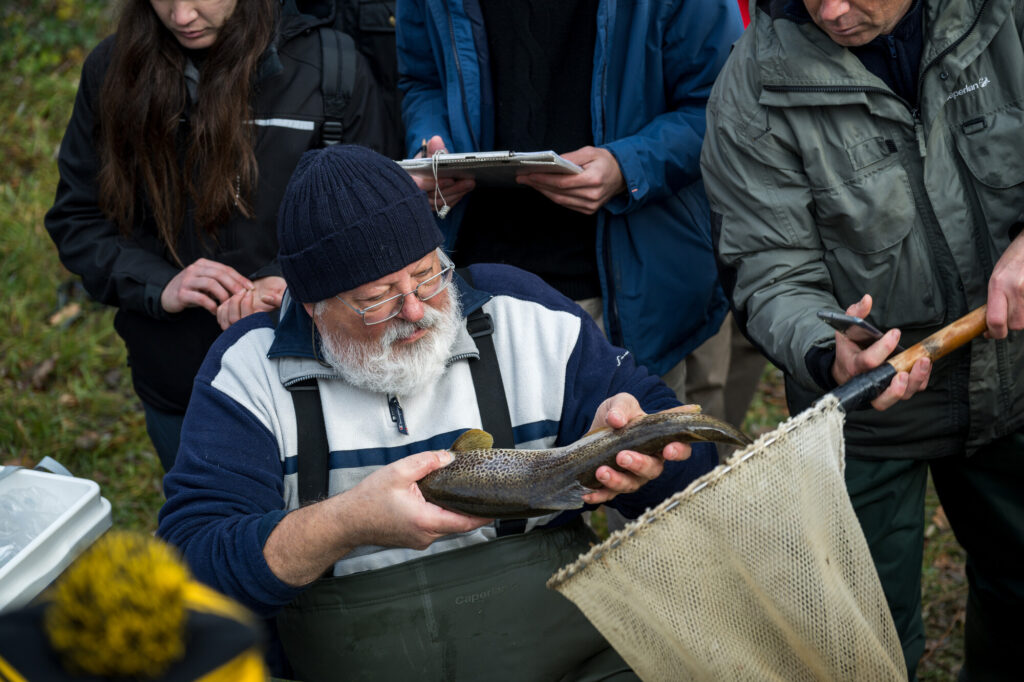Over 2,000 Mediterranean trout have just been released in a tributary of the Liri River in the Central Apennines. A leap forward in the restoration of this important native species, the release will also benefit a wide range of other wildlife and help to heal this living waterway.

Towards wilder and healthier waterways
Around 2,000 young Mediterranean trout (Salmo ghigii) have just been released into the Romito, a stream in the Central Apennines rewilding landscape in Italy, with the help of the Rewilding Apennines team and financial support from Rewilding Europe. Located within the 1,025-hectare Zompo lo Schioppo Regional Reserve, the stream is part of the basin of the Liri River. The presence of Mediterranean trout is a sign of river health – restoring populations will strengthen the pulse of a living river and benefit the myriad wildlife species connected with it.
The release marks a leap forward for the restoration of Mediterranean trout populations, which have been declining due to habitat loss and the mass introduction of non-native Atlantic trout in almost all Italian rivers. The goal is to re-establish a genetically pure population of Mediterranean trout in the reserve, with a second release of 500 fish to follow later this April, and a further release in 2026.
The beautiful Zompo lo Schioppo waterfall that gives the surrounding nature reserve its name.
Strategic location
The Romito was chosen as this part of the Liri River basin is separated from the main river by a dam that generates hydropower. While this negatively impacts the connectivity and natural functioning of the river system, it means Atlantic trout populations downstream of the dam are unable to move upstream to interbreed with the newly released fish. It also means that Mediterranean trout can migrate downstream in times of flooding. The Liri is the only river in the Abruzzo region whose basin still contains populations of genetically pure Mediterranean trout.
“This re-stocking with a native species will enhance the vitality of the stream and breathe new life to the ecosystem,” says Angela Tavone, Rewilding Apennines’ Communications Manager. “It will strengthen the food web in this part of the river and reinforce local Mediterranean trout strains, which have been endangered for too long.”
“This re-stocking with a native species will enhance the vitality of the stream and breathe new life into the ecosystem.”

Angela Tavone
Communications Manager at Rewilding Apennines
A multi-stage process
There are many stages of the Mediterranean trout lifecycle, as the fish moves between spawning habitats downstream to foraging spots and winter habitat upstream as it grows. In a similar way, the restoration process in the Romito also involves a number of steps.
The first of these saw the best Mediterranean trout for breeding identified, with tissue samples taken from 80 fish caught in the Romito downstream of the dam for genetic verification. These fish were then fitted with microchips.
Several suitable mature trout were then selected and produced three batches of fertilised eggs, which developed into trout fry in a local hatchery. The first batch of these fry have now been released into the Romito. In the summer, all non-Mediterranean trout upstream of the dam in the Romito will be caught and removed to prevent interbreeding in this section of the stream. In 2027, the team will conduct genetic sampling in this section, with the expectation of finding a notable increase in the percentage of Mediterranean trout, and a significant decrease in Atlantic trout.
The young Mediterranean trout are released into the Romito stream.
Burgeoning support for river restoration
The trout release followed a well-attended event held in the rewilding landscape in February. This brought together artists, conservationists, fishermen, and residents of local communities to celebrate the species that populate and shape Central Apennine rivers. Organised by the Rewilding Apennines team and Bruno D’Amicis – a renowned wildlife photographer and member of the Rewilding Apennines board – the “About trout and men” event focused on the importance of restoring native trout populations. It also touched on the wider restoration of rivers by the Rewilding Apennines team, which involve dam removal and support for local white-clawed crayfish populations.
Held at Cantelmo Castle in Pettorano sul Gizio, the evening included talks from trout expert Stefano Esposito, who walked the audience through a millennium of human and trout history, and Canadian ichthyologist and scientific illustrator Paul Vecsei, who presented his detailed drawings of fish species in Italian rivers. The event’s success illustrates how important native species and the overall health of local rivers and streams are to people living in the area.

A collaborative effort
The collaborative nature of the ongoing trout release initiative and monitoring efforts prove the importance of nature reserves in fostering partnerships between private organisations, academics, and scientists. The initiative is led by Professor Amilcare D’Orsi, Scientific Director of the Zompo lo Schioppo Nature Reserve, and Professor Marco Seminara of the Sapienza University of Rome. For the latest release, the support of the Sapienza University of Rome’s Department of Environmental Biology, Zooprophylactic Institute of Teramo, and Abruzzo Regional Authority played a vital role.
“The Zompo lo Schioppo Reserve represents a central point for fish conservation activities in the Liri Valley,” explains Roberto D’Amico, the mayor of Morino, a village situated at the entrance to the Zompo lo Schioppo Nature Reserve which is also responsible for managing it. “The trout restoration initiative is a cornerstone of these activities, which aim to enhance the natural value of the river and surrounding landscapes.”
The restoration of Mediterranean trout in a tributary of the Liri is a small example of the growing movement to restore and rewild rivers across the whole of Europe, which is revitalising waterways and the wildlife populations they support through measures such as dam removal, reconnecting rivers with their floodplains, and the reintroduction of keystone species. This, in turn, is enhancing the benefits that rivers deliver to people, such as clean water, flood protection, and resilience to climate change.

Invaluable support
Rewilding Europe’s work across our rewilding landscapes is supported by a wide range of highly valued partners. We would particularly like to acknowledge those providing core funding – notably the Ecological Restoration Fund, the Dutch Postcode Lottery, WWF-Netherlands, and Arcadia. Their longstanding support plays a critical role in enabling us to deliver and scale up rewilding impact.
